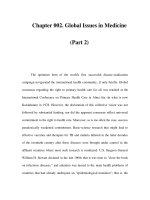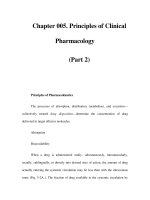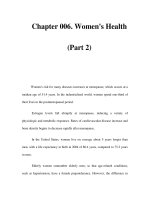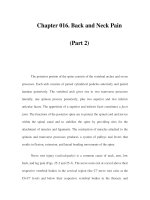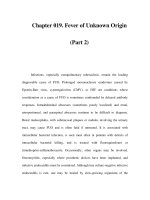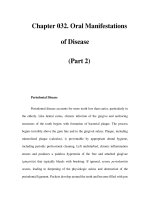Chapter 055. Immunologically Mediated Skin Diseases (Part 2) ppsx
Bạn đang xem bản rút gọn của tài liệu. Xem và tải ngay bản đầy đủ của tài liệu tại đây (36.7 KB, 5 trang )
Chapter 055. Immunologically
Mediated Skin Diseases
(Part 2)
Pemphigus Vulgaris
Pemphigus refers to a group of autoantibody-mediated intraepidermal
blistering diseases characterized by loss of cohesion between epidermal cells (a
process termed acantholysis). Manual pressure to the skin of these patients may
elicit the separation of the epidermis (Nikolsky's sign). This finding, while
characteristic of pemphigus, is not specific to this group of disorders and is also
seen in toxic epidermal necrolysis, Stevens-Johnson syndrome, and a few other
skin diseases.
Pemphigus vulgaris (PV) is a mucocutaneous blistering disease that
predominates in patients >40 years. PV typically begins on mucosal surfaces; it
often progresses to a mucocutaneous disease in which fragile, flaccid blisters
rupture to produce extensive denudation of the skin (Fig. 55-1). PV typically
involves the mouth, scalp, face, neck, axilla, groin, and trunk. PV may be
associated with severe skin pain; some patients experience pruritus as well.
Lesions usually heal without scarring, except at sites complicated by secondary
infection or mechanically induced dermal wounds. Postinflammatory
hyperpigmentation is usually present at sites of healed lesions for some time.
Figure 55-1
Pemphigus vulgaris. A. Pemphigus vulgaris demonstrating flaccid bullae
that are easily ruptured, resulting in multiple erosions and crusted plaques. B.
Pemphigus vulgaris almost invariably involves the oral mucosa and may present
with erosions involving the gingiva, buccal mucosa, palate, posterior pharynx, or
the tongue. (B, Courtesy of Robert Swerlick, MD.)
Biopsies of early lesions demonstrate intraepidermal vesicle formation
secondary to loss of cohesion between epidermal cells (i.e., acantholytic blisters).
Blister cavities contain acantholytic epidermal cells, which appear as round
homogeneous cells containing hyperchromatic nuclei. Basal keratinocytes remain
attached to the epidermal basement membrane, hence blister formation is within
the suprabasal portion of the epidermis. Lesional skin may contain focal
collections of intraepidermal eosinophils within blister cavities; dermal alterations
are slight, often limited to an eosinophil-predominant leukocytic infiltrate. Direct
immunofluorescence microscopy of lesional or intact patient skin shows deposits
of IgG on the surface of keratinocytes; deposits of complement components are
typically found in lesional but not uninvolved skin. Deposits of IgG on
keratinocytes are derived from circulating autoantibodies directed against cell-
surface autoantigens. Such circulating autoantibodies can be demonstrated in 80–
90% of PV patients by indirect immunofluorescence microscopy; monkey
esophagus is the optimal substrate for these studies. Patients with PV have IgG
autoantibodies directed against desmogleins (Dsgs), transmembrane desmosomal
glycoproteins that belong to the cadherin family of calcium-dependent adhesion
molecules. Such autoantibodies can be precisely quantitated by enzyme-linked
immunosorbent assay (ELISA). Patients with early PV (i.e., mucosal disease) have
only IgG autoantibodies directed against Dsg3; patients with advanced PV (i.e.,
mucocutaneous disease) have IgG autoantibodies directed against both Dsg3 and
Dsg1. Experimental studies have shown that autoantibodies from patients with PV
are pathogenic (i.e., responsible for blister formation) and that their titer correlates
with disease activity. Recent studies have shown that the anti-Dsg autoantibody
profile in these patients' sera as well as the tissue distribution of Dsg3 and Dsg1
determine the site of blister formation in patients with pemphigus. Coexpression of
Dsg3 and Dsg1 by epidermal cells protects against pathogenic IgG directed
against either cadherin but not pathogenic autoantibodies directed against both.
PV can be life-threatening. Prior to the availability of glucocorticoids, the
mortality ranged from 60–90%; the current mortality is ~5%. Common causes of
morbidity and mortality are infection and complications of treatment with
glucocorticoids. Bad prognostic factors include advanced age, widespread
involvement, and the requirement for high doses of glucocorticoids (with or
without other immunosuppressive agents) for control of disease. The course of PV
in individual patients is variable and difficult to predict. Some patients achieve
remission, while others may require long-term treatment or succumb to
complications of their disease or its treatment. The mainstay of treatment is
systemic glucocorticoids. Patients with moderate to severe PV are usually started
on prednisone, 1 mg/kg per day. If new lesions continue to appear after 1–2 weeks
of treatment, the dose may need to be increased. Many regimens combine an
immunosuppressive agent with systemic glucocorticoids for control of PV. The
most frequently used are azathioprine (2–2.5 mg/kg per day), mycophenolate
mofetil (20–35 mg/kg per day), or cyclophosphamide (1–2 mg/kg per day).
Patients with severe, treatment-resistant disease may derive benefit from
plasmapheresis [six high-volume exchanges (i.e., 2–3 liters per exchange) over ~2
weeks], IV immunoglobulin (2 g/kg over 3–5 days every 6–8 weeks), or rituximab
(375 mg/m
2
per week x 4). It is important to bring severe or progressive disease
under control quickly to lessen the severity and/or duration of this disorder.

